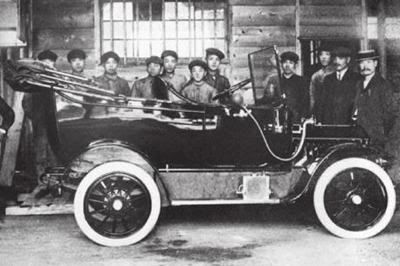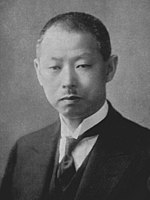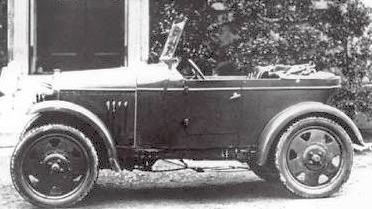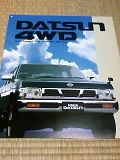The Datsun brand of cars came out of the merger of two early Japan car companies, DAT Automobile Co. and Jitsuyo Automobile Co. This new company DAT Automobile Manufacturing Co., Ltd. eventually created the Datsun brand. Shortly after the first Datsun was produced in 1931, the fledgling Nippon Sangyo holding company, desiring to enter the automobile business, sets its eyes on the Datsun car. So in 1933 it takes over DAT. The next year Nippon Sangyo names the car company Nissan Motors. The rest is history.
Contents |
Kwaishinsha
1911: Masujiro Hashimoto forms ??????? with backers of Den, Aoyama and Takeuichi. Intials DAT are eventually applied to name the car project. In Japanese DAT (pronounced 'datto') means 'bounding away' -- a derivation of the word for rabbit/hare -- so it is fitting for ambitious automobile hopes.
1912: Hashimoto builds first prototype DAT automobile
1913: Second car, the DAT 1, is created
1914 March: DAT 1 wins a prize at Tokyo Taisho Expo
1914: ??????? (Kwaishinsha Automobile Works) is established in Tokyo. Apparently it is the first automobile manufacturer registered with the Japanese government.
1915: DAT 31 birth, with 2-liter 4-cylinder engine fitting
1916: DAT 41 birth, with bored 2.3-liter engine. Produced until 1926.
1918: Renamed to Kwaishinsha Automobile Co.
Jitsuyo
1919: Kubota (the tractor company) forms a subsidiary to manufacture cars, named it ????? (Jitsuyo Automobiles) in Osaka. American William R. Gorham previously had approached Kubota with a design for a design for a two passenger three-wheeled car powered by Harley-Davidson motorcycle engine. Gonshiro Kuboto, company head, creates Jitsuyo with W.R. Gorham as Chief Engineer.
1920: Jitsuyo's first product is the small three-wheeled "Gorham" car. Production of Gorham 3-wheeler continues until 1922. About 150 Gorhams are sold.
1921: William R. Gorham and Takayoshi Goto create a four-wheel car design, but then Gorham leaves Jitsuyo to work for Tobata Castings. About 100 of these cars are sold.
1921: Takayoshi Goto creates the Lila Light Car, based on a rework of Gorham's original design.
-

- Jitsuyo Lila
- production from 1922-1926, about 200 cars total production
- 10 HP, top speed 30 mph
- both car and truck models offered
- popular in Tokyo taxi market due to narrow 40-inch track
Merger of DAT and Jitsuyo
1926: DAT and Jitsuyo merge, to form ???????????? (DAT Automobile Manufacturing Co., Ltd.). Headquarters are in Osaka. Jitsuyo, in the face of intense competition from Ford and GM in Japan, was only selling about 150 cars per year. It barely survived by taking on work from Kubota and even GM. Therefore a merger with DAT was sought. DAT had military truck contracts, so was in better condition than Jitsuyo.
1930: New small car design completed, with 500cc engine fitting
DAT Co.
1925: Kwaishinsha Automobile Co. is renamed to DAT Automobile Co.
Nippon Sangyo
1928: Yoshisuke Aikawa founds the holding company Nippon Sangyo (Japan/Nippon Industries). This fledging company soon begins buying or taking over other established companies.
- Yoshisuke Aikawa in 1939
Takeover of DAT
1931: Nippon Sangyo controls foundries and auto parts businesses, but no automobile manufacturing. Aikawa purchases controlling shares in DAT Motors
Aikawa, with William R. Gorham as technical advisor, build largest automobile manufacturing factory in Japan. They purchase entire production lines from the troubled american Graham-Paige company, including production tools and truck designs. Import/Export specialist Mitsubishi is engaged to import the american equipment into Japan. Do to this expansion and modern tooling, DAT gets advantage over all other Japan car producers.
First Datsun
1931 August: DAT comes out with a new smaller car, the first Datson, meaning "Son of DAT". It is a two-passenger car.
1932: Datson mark is renamed Datsun, a more harmonious spelling. Reportedly though perhaps apocryphal, is that after the DAT factory was victimized by flooding during a typhoon, it was attributed to the "son" in Datson (son in Japanese means 'loss'). In any case, the spelling was changed to "sun". Interestingly it fits with the Japanese 'sun' flag logo shown on the 1931 Dotson catalog. Sun has no particular meaning in Japanese, except that it is pronounced 'san'. Nominally, san is a title of respect, roughly equivalent to the english Mr. or Mrs.
- 1932 Datsun
- 1932 production: 150 Datsuns
During this time, reportedly, Lord Austin in the UK (the head of the Austin car manufacturer) heard that the Datsun was a copy of the Austin 7. The book 'Car Wars' says Austin had a Datsun obtained in Japan, shipped to England and gone over with a fine tooth comb. The result? Austin could not find anything to sue over. Some say the size, design and engine look similar to the Austin 7, however the engine is much smaller and the car design has significant differences from the Austin 7. We may conclude, that as with many cars around the world at that time, the Austin 7 probably influenced the design of the Datsun but that the Datsun was not a copy.
1933: Aikwawa merges Tobata Casting's automobile parts department with DAT Automobile. The Company is renamed ????????? (Jidosha-Seizo Co., Ltd.)
DAT truck production is separated off and merged with Ishikawajima and TGE, the new company being named Tokyo Jidosha Kogyo. It will eventually be named Isuzu.
Nissan
1934: Aikawa "separated the expanded automobile parts division of Tobata Casting and incorporated it as a new subsidiary, which he named Nissan Motor (Nissan)". This is ????? (Nissan Motor Co., Ltd.), incorporated as a public company.
1934 June: The shareholders of the new company however are not enthusiastic about the prospects of the automobile in Japan, so Aikawa buys out all the Tobata Casting shareholders (using capital from Nippon Industries). At this time Nissan Motors effectively becomes owned by Nippon Sangyo and Hitachi.
1934: 880 Datsuns produced
1935: Time Magazine features Datsun in article, although Datsuns will not be sold in america until 1958
1936: Datsun Type 15 birth
1937: First Nissan-branded car introduced, the Nissan Type 70
1940s: Nippon Sangyo, now popularly known as Nissan, becomes the famous Nissan "Zaibatsu" (combine) including Tobata Casting and Hitachi. It grows to include 74 firms, and to be the fourth-largest combine in Japan during the wartime years.
1947: For two years (1947 to 1948) the company was briefly called Nissan Heavy Industries Corp.
Nissan and Austin
1953: In the postwar era, like Hino and Isuzu, but unlike Toyota, Nissan partnered with an established European company to gain access to automobile and engine designs. Nissan chose Austin of the United Kingdom. They entered into a well-documented legal agreement with Austin, for Nissan to assemble 2,000 Austins from imported partially assembled sets and sell them in Japan under the Austin trademark. The agreement called for Nissan to make all Austin parts locally within three years, a goal Nissan met. Nissan produced and marketed Austins for seven years. The agreement also gave Nissan rights to use Austin patents, which Nissan used in developing its own engines for its Datsun line of cars. In 1953 British-built Austins were assembled and sold, but by 1955, the Austin A50 -- completely built by Nissan and featuring a slightly larger body with new 1489 cc engine -- was on the market in Japan. Nissan produced 20,855 Austins from 1953-1959.
As as a result of Nissan manufacturing and cross-license of Austins, Nissan leveraged the Austin patents to further develop their own modern engine designs past what the Austin's A- and B-family designs offered. The apex of the Austin-derived engines was the new design A series engine in 1966.
Datsun Sunny
1966: Datsun Sunny birth with all-new 1000cc aluminum-head Nissan A Engine.
1970: Datsun Sunny 1200 birth
- See main article: History of Datsun 1200
-

End of Datsun Brand
1981-1983: After becoming one of the world's great brand names, Datsun brand name is globably replaced with Nissan badging. This was to achieve greater recognition for the Company (Nissan) rather than the better-known Brand (Datsun).
1989 November: Japan model Datsun 1200 pickup, lacking Datsun badges for some years, is formally badged as a Nissan
1993-1995: Datsun name used as a model name in Japan for the D21 pickup, known as Navara or Harbody in other countries.
End of Datsun 1200 Line
1994: Nissan ends production of Datsun 1200 pickup (now called Nissan Sunny Truck) in Japan.
- See main article: B120
2007 November: Nissan South Africa ceases production of the Datsun 1200-bodied based Nissan LDV 1400 small pickup.
- See main article: B140

![[Datsun 1200 encyclopedia]](/wiki/upload/wiki.png)







